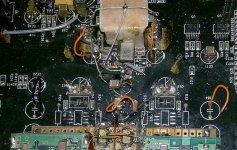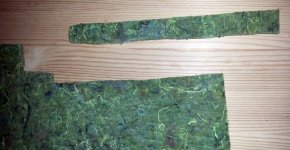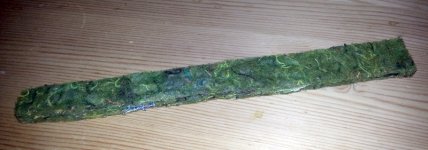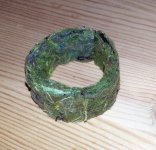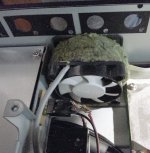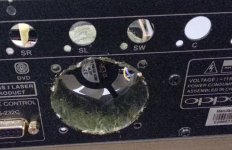I think in the case of oscillators is not about increase stability at increased frequency, but about better jitter and phase noise parameters at higher base frequency, than lower ones. Actually say, the jitter it will decrease (figures) at higher oscillation frequencies. Will decrease under an level which will affect less the rest of the involved devices around it (audio/digital applications), but could still be an important/disturbing value for another applications (radio field, measurements devices, etc.). There is a fact that at higher oscillator frequency, the jitter become lower, comparing with a lower frequency oscillator case. This is logic enough and will affect positive clocking devices which will work at quite low frequencies, like the f. ex. DACs for audio applications. Is more benefit to generate a clock signal using the highest possible frequency oscillator (lowest jitter/phase noise), then heaving an (maybe expensive/sophisticated) oscillator near the needed clock frequency. I think this can explain better results in the case of Sabre DAC, when the clock generator have higher frequencies... But lack of detailed informations about this DAC chip can make this explanation quite diffuse...
When about the SAW type oscillators, I can see that it were developed for use in an quite high vibrations environment (like airplains f. ex.). In audio applications those vibrations are not as high as in an (aircraft) industry environment, but theirs stability at disturbing/parasitic parameters can really increase the quality of the generated clock in an audio DAC (f. ex.)... Just curious to see/hear how it works...
When about the SAW type oscillators, I can see that it were developed for use in an quite high vibrations environment (like airplains f. ex.). In audio applications those vibrations are not as high as in an (aircraft) industry environment, but theirs stability at disturbing/parasitic parameters can really increase the quality of the generated clock in an audio DAC (f. ex.)... Just curious to see/hear how it works...
Last edited:
.. Just curious to see/hear how it works...
Yes indeed, and I am curious what your feedback will be.
Well, I like what I am hearing and quite happy to let others know, especially if this proves the way to go. This is definitely superior to anything I have hooked up to a Sabre DAC.
Cheers, Joe
Yes, indeed... I can confirm it. This oscillator is the best of all I`ve tried in this mod. Thanks for advice!
More detailed sound stage, better defined everything in the stage, and an exceptional deep/natural bass...
I will never go back to 100Mhz oscillator, no matter it is called Crystek, but I have to try synchronous clock one day (using a Buffalo DAC board)...
I think I have to precise here that this (clock) mod is not based on informations about the set up of ESS9018, its firmware parameters, and so on. As it is the software used for the Sabre DAC in this Oppo player, it works much more better at the higher frequencies than the original oscillator (54Mhz), and the best result it seems to be using this SAW oscillator.
Still waiting see/read from another ones results, and maybe get some thanks from Oppo itself for this offered for free product development work...
More detailed sound stage, better defined everything in the stage, and an exceptional deep/natural bass...
I will never go back to 100Mhz oscillator, no matter it is called Crystek, but I have to try synchronous clock one day (using a Buffalo DAC board)...
I think I have to precise here that this (clock) mod is not based on informations about the set up of ESS9018, its firmware parameters, and so on. As it is the software used for the Sabre DAC in this Oppo player, it works much more better at the higher frequencies than the original oscillator (54Mhz), and the best result it seems to be using this SAW oscillator.
Still waiting see/read from another ones results, and maybe get some thanks from Oppo itself for this offered for free product development work...
Attachments
Last edited:
I have plenty of extra Linear power modification PCBs left.
I want to share with other DIYers.
Pm me if you want. I also have dedicated troidal transformers and other parts for this project.
Good clock circuitary must get the power form linear power source.

good look! good sound? or this for video only?
I have plenty of extra Linear power modification PCBs left.
I want to share with other DIYers.
Pm me if you want. I also have dedicated troidal transformers and other parts for this project.
Good clock circuitary must get the power form linear power source.

Hi Jea Hong Lee
How is this for 25Mhz ocxo?
Is it ok for the Oppo BD93
OX1439C-LV-10 25 MHz 0.1ppm OCXO oscillator Raltron | eBay
Many thanks for any help
Smiffy
I... Been down the CD and modded CD /dvd gizmo path before.. repeatedly... as there are very few ( 2 or 3?) CD selling shops left standing Here in Vancouver. Who the hell ..buys ..CD's these days?? Old men I suppose?
I think you have missed the point. I barely use my Oppo for disks, even though it does the near gamut of formats. No, I have 800 albums on a HDD with many of them 24bit recordings. Like for example Fleetwood Mac "Rumours" at 24/192K.
So we get the best of both worlds. Files and disks. Inbuilt menu system.
Also, the Oppo 95 comes with the top-of-line 32bit Sabre DAC, not the usual delta-sigma, and an inbuilt remote volume control with 99 different levels (need the latest firmware) that may well be (nobody is saying for sure) is 64bit.
Not everybody is getting the best out of the Sabre DAC, but when you know how to, then it's a winner.
Cheers, Joe R.
PS: BTW, I am not a videophile, but oh boy, when I do watch one, the audio of this player adds a huge dimension to watching a movie.
Yes, indeed... I can confirm it. This oscillator is the best of all I`ve tried in this mod. Thanks for advice!
More detailed sound stage, better defined everything in the stage, and an exceptional deep/natural bass...
I will never go back to 100Mhz oscillator, no matter it is called Crystek, but I have to try synchronous clock one day (using a Buffalo DAC board)...
See, I told you so. I don't know if you can get them as low as 25MHz, I think they start at around 70MHz and go up.
I think I have to precise here that this (clock) mod is not based on informations about the set up of ESS9018, its firmware parameters, and so on. As it is the software used for the Sabre DAC in this Oppo player, it works much more better at the higher frequencies than the original oscillator (54Mhz), and the best result it seems to be using this SAW oscillator.
According to ESS, the max is 100MHz. This satisfies their requirements for DSD Data, Serial Normal, Serial Bypass and SPDIF.
But SAW oscillators are so stable it seems. I have now been running 125MHz for some time and nothing amiss.
Cheers, Joe R.
Is true also, I`ve seen that after wrote the post... The SAW oscillators are not made for quite low frequencies.
I`ve run it ESS9018 on 133Mhz (as is to be seen in my earlier posts in this thread and another one). It were a little problems at that frequency in some particular cases. I`ve also run it too at 125Mhz, but I did not have a very good oscillator (only a standard one) at that frequency, but it was running very well.
The SAW oscillator is much better, therefore the result now is very good. Better than at multiple samplings frequencies.
I just wander why so long the chip is made (as the designer state) for an max 100Mhz clock it runs even better at those clock frequencies we tested it (over 100Mhz)...
I`ve run it ESS9018 on 133Mhz (as is to be seen in my earlier posts in this thread and another one). It were a little problems at that frequency in some particular cases. I`ve also run it too at 125Mhz, but I did not have a very good oscillator (only a standard one) at that frequency, but it was running very well.
The SAW oscillator is much better, therefore the result now is very good. Better than at multiple samplings frequencies.
I just wander why so long the chip is made (as the designer state) for an max 100Mhz clock it runs even better at those clock frequencies we tested it (over 100Mhz)...
Last edited:
Smiffy is the oscillator 0.1 ppm or 10 ppm according to the manufacturer's description?
For an OCXO oscillator 10ppm may not be possible. More reasonable would be 0,1ppm.
I think one may have doubt about components parameters sold on the ebay marked. It may be good, but it may be wrong. Those components can come from rejected batches after testing...
I think its ST cut but part numbers dont seem to quite match up with the manufacturers numbers
Pt number is OX 1439C-LV-10 whereas on pdf i would have expected it to be OX4139C
http://raltron.com/products/pdfspecs/ocxo_ox3000.pdf
Maybe me having an off day
Smiffy
Pt number is OX 1439C-LV-10 whereas on pdf i would have expected it to be OX4139C
http://raltron.com/products/pdfspecs/ocxo_ox3000.pdf
Maybe me having an off day
Smiffy
Last edited:
Personally I do not have very much trust in what is sold on Ebay. Quite expensive (as usual) components sold for low prices. They can attach the data sheet, which cam look nice and so on. But how one can know if in fact the component really have those parameters specified in the data sheet? When one buy from a well known retailer, there is a bigger chance for that specified parameters in data sheet are reflected in the product/component. Anyway, the percentage of that chance is very big comparing with an really unknown retailer/seller on, for say Ebay marked. A well known retailer will not want to compromise its name selling wrong, doubtful or out of parameters products.
When is about a very precise/stable and high quality clock oscillator, I would prefer to be sure about its parameters before using it in a high end device. Specially when is to be concluded about increasing quality of that device after using a such clock... The other side of this way of thinking is a very high price paid for that high quality clock...
This is my way of thinking... But this do not mean that one do not have to try...
So yours to chose and take the risks...
When is about a very precise/stable and high quality clock oscillator, I would prefer to be sure about its parameters before using it in a high end device. Specially when is to be concluded about increasing quality of that device after using a such clock... The other side of this way of thinking is a very high price paid for that high quality clock...
This is my way of thinking... But this do not mean that one do not have to try...
So yours to chose and take the risks...
Last edited:
Personally I do not have very much trust in what is sold on Ebay. Quite expensive (as usual) components sold for low prices. They can attach the data sheet, which cam look nice and so on. But how one can know if in fact the component really have those parameters specified in the data sheet? When one buy from a well known retailer, there is a bigger chance for that specified parameters in data sheet are reflected in the product/component. Anyway, the percentage of that chance is very big comparing with an really unknown retailer/seller on, for say Ebay marked. A well known retailer will not want to compromise its name selling wrong, doubtful or out of parameters products.
When is about a very precise/stable and high quality clock oscillator, I would prefer to be sure about its parameters before using it in a high end device. Specially when is to be concluded about increasing quality of that device after using a such clock... The other side of this way of thinking is a very high price paid for that high quality clock...
This is my way of thinking... But this do not mean that one do not have to try...
So yours to chose and take the risks...
Think i'll leave it then Coris.If i'm gonna pop in a high quality clock may as well know its high quality before all the work.Ta for the advice
Smiffy
Another way to get rid of the fan noise in BDP95
...and in general when about a noiseless functioning fan...
The idea is to isolate the fan using an sound absorbent or elastic mounting, and prevent its vibrations to be transmitted to the rest of the enclosure. In the same time assuring an turbulence less air flow out of the enclosure.
I used an quite common sound isolating/textile mate which is used to cover the inside of the speaker boxes.
I cut it that mate as is to be seen in picture, to make an cylinder of it, with the same diameter as the fan propel. Used an quick elastic glue to finish this. I glued with the same glue the fan on that made it cylinder. Then everything glued on the right place of the original fan. The fan have to be suspended and sustained only on/by that sound absorbent cylinder. That`s all.
The result: the whole fan noise is gone! The most also...
...and in general when about a noiseless functioning fan...
The idea is to isolate the fan using an sound absorbent or elastic mounting, and prevent its vibrations to be transmitted to the rest of the enclosure. In the same time assuring an turbulence less air flow out of the enclosure.
I used an quite common sound isolating/textile mate which is used to cover the inside of the speaker boxes.
I cut it that mate as is to be seen in picture, to make an cylinder of it, with the same diameter as the fan propel. Used an quick elastic glue to finish this. I glued with the same glue the fan on that made it cylinder. Then everything glued on the right place of the original fan. The fan have to be suspended and sustained only on/by that sound absorbent cylinder. That`s all.
The result: the whole fan noise is gone! The most also...
Attachments
Last edited:
Youd be better using a closed cell neoprene faom or a even better slow recovery foam (memory foam):
http://www.pfa.org/intouch/pdf/IntouchV11_1_read.pdf
This is very good at absorbing vibration, due to cost and problemswith working often only used in this area in more exotic (mil/aero medical) products. But for DIY use where production costs are not paramount (takes for ages to cut due to slow recovery properties) its great. There are different grades, but the foamout of a decent pillow willlast for ages.
http://www.pfa.org/intouch/pdf/IntouchV11_1_read.pdf
This is very good at absorbing vibration, due to cost and problemswith working often only used in this area in more exotic (mil/aero medical) products. But for DIY use where production costs are not paramount (takes for ages to cut due to slow recovery properties) its great. There are different grades, but the foamout of a decent pillow willlast for ages.
At CEDIA Oppo showed preview units of the new BDP-103/105 BD players:
New or Enhanced BDP-103/105 Shared Features:
Latest generation QDEO which supports 4K upscaling
2x2 HDMI. Two HDMI inputs; Two HDMI outputs.
The Front HDMI input supports MHL (Mobile High-Definition Link) which allows some of the newer smartphones to be connected direct to the player and transmits the phones screen to the television. This also allows for ROKU Stick support.
Newest Netflix interface which supports 1080p video, multi-channel audio, subtitle and alternative language selection, and Family Interface
Gracenote for looking up media information such as album art, artist, album, and track information for your CD, SACD, and user generated media
Backlit Eject buttons. No more thumbing around in the dark.
No more analog video. There is a "DIAG" port, but this is to only see the OPPO UI when there is no media playback. So for those of you who use a small monitor for media playback, you will need to upgrade to a DVI/HDMI capable display.
New BDP-105 Only Features:
Fanless (unlike the BDP-95)
Headphone Amplifier
works as an asynchronous USB DAC
Optical and Digital Coaxial Inputs
Properly oriented XLR outputs
New or Enhanced BDP-103/105 Shared Features:
Latest generation QDEO which supports 4K upscaling
2x2 HDMI. Two HDMI inputs; Two HDMI outputs.
The Front HDMI input supports MHL (Mobile High-Definition Link) which allows some of the newer smartphones to be connected direct to the player and transmits the phones screen to the television. This also allows for ROKU Stick support.
Newest Netflix interface which supports 1080p video, multi-channel audio, subtitle and alternative language selection, and Family Interface
Gracenote for looking up media information such as album art, artist, album, and track information for your CD, SACD, and user generated media
Backlit Eject buttons. No more thumbing around in the dark.
No more analog video. There is a "DIAG" port, but this is to only see the OPPO UI when there is no media playback. So for those of you who use a small monitor for media playback, you will need to upgrade to a DVI/HDMI capable display.
New BDP-105 Only Features:
Fanless (unlike the BDP-95)
Headphone Amplifier
works as an asynchronous USB DAC
Optical and Digital Coaxial Inputs
Properly oriented XLR outputs
works as an asynchronous USB DAC
That alone would be top of the list for many I suspect. But I don't see anything I need desperately.
Cheers, Joe R.
- Home
- Source & Line
- Digital Source
- Upgrading & modding new Oppos, BDP-93 & BDP-95
